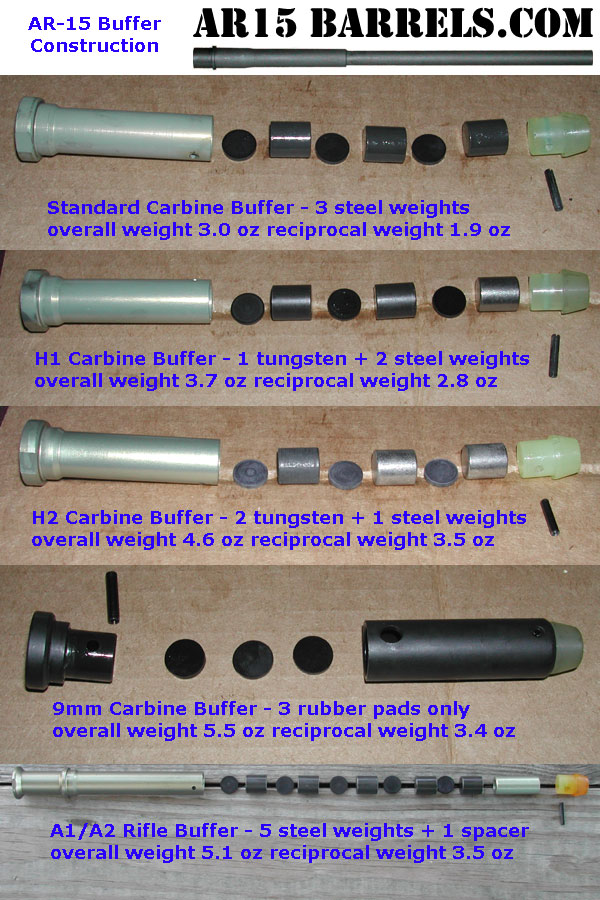I just ask bc sometimes pmag's can have difficulty locked the bolt back depending on the setup.
I agree it is a good question. I read about lots of pmag failures through google. I should have clarified from the beginning.
If you enjoy the forum please consider supporting it by signing up for a NES Membership The benefits pay for the membership many times over.
Be sure to enter the NES/MFS May Giveaway ***Canik METE SFX***
I just ask bc sometimes pmag's can have difficulty locked the bolt back depending on the setup.
The old buffer shaked around. The new one does not.
Yeah, I had a feeling that would be the case. You have a cheap-ass buffer, get a non-cheap-ass buffer and things should be good.
So are you saying it should shake around?
So are you saying it should shake around?
Buffers are not (supposed to be) solid, they are filled with tungsten or similar material so that they function similar to a dead-blow hammer.
Buffers are not (supposed to be) solid, they are filled with tungsten or similar material so that they function similar to a dead-blow hammer.
I never really heard of a over gassed gun not locking back . That more of a under gas problem.
The Bolt tries to unlock before the chamber pressure has dropped, so the case sticks to the chamber wall, slowing down the bcg speed.
That makes sense . So how do you tell if it's from over gas be under gas . Does the brass show signs ?
yep, the rim will be chewed up from the extractor
I found and posted a graphic (earlier in the thread) that shows how to tell based on ejection pattern. The graphic isn't mine and was found through a lot of searching. This was thread where I found it:
https://www.okshooters.com/showthread.php?160495-AR-15-Buffer-weights
Anthony
The Bolt tries to unlock before the chamber pressure has dropped, so the case sticks to the chamber wall, slowing down the bcg speed.

okay but if the rifle worked fine with the original buffer, tube, and spring, then I don't think that's what's happening here. It seems like the gas system worked fine and the only thing that changed with the buffer, tube and spring.
I was also thinking it's short cycling and not over gassed. Where the brass lands, and how far it goes, can sometimes be an indicator--far forward could be over gassed and short distance to the rear would be more under--but it's not an exact science.
The other thing I would do, just because it's so easy, is with the rifle unloaded, close the bolt then insert an empty mag and pull back the bolt and release it--does it lock back?
Did the OP put grease or something in the buffer tube? You shouldn't put anything in there--although some makers will put in a tiny bit of grease. Looking at what you got on Amazon there are some bad reviews. Some say the buffer is a sloppy fit in the tube and i wonder if that would slow down the cycle and cause short cycling? But do try a friend's buffer and/or carbine spring to see if it makes a difference.
FWIW, I never buy gun parts from Amazon or no-name brands. The LMT tube, spring, and buffer is like $60, which is twice as much but really just $30 more--and that's for a top notch brand. Back when I took the Armalite armorer course they warned us about cheaply made buffers full of solid lead, shotgun pellets, or misc trash. The buffer should rattle and have three cylinders floating inside it, like these:
My comments weren't about fixing his rifle, just about diagnosing an overgassed gun. For his specific gun, I agree with you...crap parts
is this for a real gun not an air soft?
okay but if the rifle worked fine with the original buffer, tube, and spring, then I don't think that's what's happening here. It seems like the gas system worked fine and the only thing that changed with the buffer, tube and spring.
I was also thinking it's short cycling and not over gassed. Where the brass lands, and how far it goes, can sometimes be an indicator--far forward could be over gassed and short distance to the rear would be more under--but it's not an exact science.
The other thing I would do, just because it's so easy, is with the rifle unloaded, close the bolt then insert an empty mag and pull back the bolt and release it--does it lock back?
Did the OP put grease or something in the buffer tube? You shouldn't put anything in there--although some makers will put in a tiny bit of grease. Looking at what you got on Amazon there are some bad reviews. Some say the buffer is a sloppy fit in the tube and i wonder if that would slow down the cycle and cause short cycling? But do try a friend's buffer and/or carbine spring to see if it makes a difference.
FWIW, I never buy gun parts from Amazon or no-name brands. The LMT tube, spring, and buffer is like $60, which is twice as much but really just $30 more--and that's for a top notch brand. Back when I took the Armalite armorer course they warned us about cheaply made buffers full of solid lead, shotgun pellets, or misc trash. The buffer should rattle and have three cylinders floating inside it
